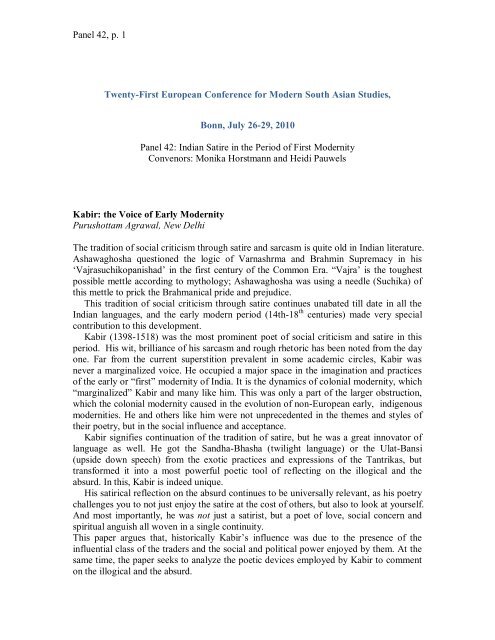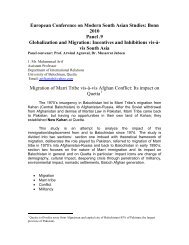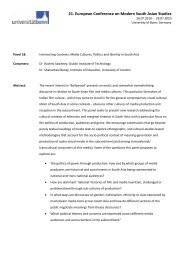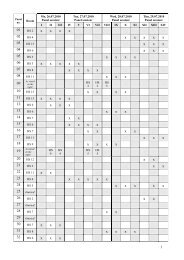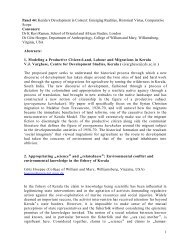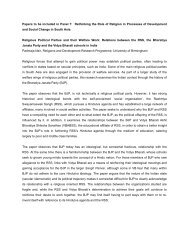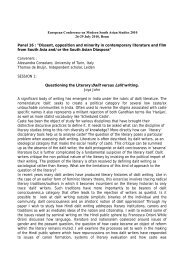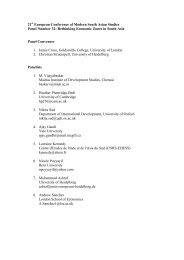Twenty-First European Conference for Modern South Asian Studies,
Twenty-First European Conference for Modern South Asian Studies,
Twenty-First European Conference for Modern South Asian Studies,
You also want an ePaper? Increase the reach of your titles
YUMPU automatically turns print PDFs into web optimized ePapers that Google loves.
Panel 42, p. 1<br />
<strong>Twenty</strong>-<strong>First</strong> <strong>European</strong> <strong>Conference</strong> <strong>for</strong> <strong>Modern</strong> <strong>South</strong> <strong>Asian</strong> <strong>Studies</strong>,<br />
Bonn, July 26-29, 2010<br />
Panel 42: Indian Satire in the Period of <strong>First</strong> <strong>Modern</strong>ity<br />
Convenors: Monika Horstmann and Heidi Pauwels<br />
Kabir: the Voice of Early <strong>Modern</strong>ity<br />
Purushottam Agrawal, New Delhi<br />
The tradition of social criticism through satire and sarcasm is quite old in Indian literature.<br />
Ashawaghosha questioned the logic of Varnashrma and Brahmin Supremacy in his<br />
„Vajrasuchikopanishad‟ in the first century of the Common Era. “Vajra‟ is the toughest<br />
possible mettle according to mythology; Ashawaghosha was using a needle (Suchika) of<br />
this mettle to prick the Brahmanical pride and prejudice.<br />
This tradition of social criticism through satire continues unabated till date in all the<br />
Indian languages, and the early modern period (14th-18 th centuries) made very special<br />
contribution to this development.<br />
Kabir (1398-1518) was the most prominent poet of social criticism and satire in this<br />
period. His wit, brilliance of his sarcasm and rough rhetoric has been noted from the day<br />
one. Far from the current superstition prevalent in some academic circles, Kabir was<br />
never a marginalized voice. He occupied a major space in the imagination and practices<br />
of the early or “first” modernity of India. It is the dynamics of colonial modernity, which<br />
“marginalized” Kabir and many like him. This was only a part of the larger obstruction,<br />
which the colonial modernity caused in the evolution of non-<strong>European</strong> early, indigenous<br />
modernities. He and others like him were not unprecedented in the themes and styles of<br />
their poetry, but in the social influence and acceptance.<br />
Kabir signifies continuation of the tradition of satire, but he was a great innovator of<br />
language as well. He got the Sandha-Bhasha (twilight language) or the Ulat-Bansi<br />
(upside down speech) from the exotic practices and expressions of the Tantrikas, but<br />
trans<strong>for</strong>med it into a most powerful poetic tool of reflecting on the illogical and the<br />
absurd. In this, Kabir is indeed unique.<br />
His satirical reflection on the absurd continues to be universally relevant, as his poetry<br />
challenges you to not just enjoy the satire at the cost of others, but also to look at yourself.<br />
And most importantly, he was not just a satirist, but a poet of love, social concern and<br />
spiritual anguish all woven in a single continuity.<br />
This paper argues that, historically Kabir‟s influence was due to the presence of the<br />
influential class of the traders and the social and political power enjoyed by them. At the<br />
same time, the paper seeks to analyze the poetic devices employed by Kabir to comment<br />
on the illogical and the absurd.
Panel 42, p. 2<br />
Jain Satire and Religious Identity in Tamiḻ-Speaking Literary Culture<br />
Anne Monius, Harvard Divinity School, Cambridge, MA<br />
Even a quick survey of pre-colonial Tamiḻ literature reveals Jain monastic poets to be the<br />
masters of the satirical. The Nīlake ci and the Civakacintamani, the Perunkatai and the<br />
Cudamani, the Yacotarakaviyam and the Utayanankatai--all sparkle not only with poetic<br />
elegance and narrative complexity, but with biting wit aimed at king and court, Hindu<br />
and Buddhist, glutton and hedonist. While the anti-Jain Śaiva invectives of early bhakti<br />
literature have been studied at length, this Jain (more specifically, Jain monastic)<br />
propensity <strong>for</strong> satire has been little examined. Why would Jain monks compose lengthy<br />
poetic narratives on the classical Tamiḻ themes of love and war, most often retelling<br />
stories well-known from Sanskrit and Prakrit sources in a new key? What role might the<br />
composition and consumption of lengthy poetic satire have played in Jain monastic<br />
discipline? In wider Tamiḻ-speaking literary culture? What historical circumstances might<br />
have given rise to these many Tamiḻ Jain satirical pieces, and what influence might they<br />
have exerted on wider Tamiḻ literary practices? This paper will explore the questions<br />
above, arguing that Jain satire shaped pre-modern Tamiḻ literary culture in numerous<br />
ways and provided an important stimulus to <strong>for</strong>mulating the literary identities of non-Jain<br />
sectarian communities in <strong>South</strong> India, primarily the Śaiva.<br />
The Bhāruds of Eknath: Per<strong>for</strong>mance, humour and satire<br />
Rohini Mokashi-Punekar, IIT, Guwahati<br />
While Marathi literature of the late colonial and post-colonial period has large numbers<br />
of satirical works, significant elements of satire are on display in the poetry of<br />
Maharashtra‟s sant-kavi of the Varkari panth who are devotees of the god Vitthal in<br />
Pandharpur. Amongst these, the 16 th century Brahmin scholar-poet Eknath has a unique<br />
position, since Eknath not only put together the first critical edition of the Dnyaneswari<br />
which is the authoritative version even today and wrote a commentary on the eleventh<br />
skanda of the Bhāgwata Purāna among a vast number of scholarly works in the śastric<br />
tradition, but was also the author of several thousand abhangs and some three hundred<br />
bhāruds, a popular <strong>for</strong>m of folk drama-poem. Eknath‟s bhāruds continue to be per<strong>for</strong>med<br />
today in bhajan groups and kirtans, as part of the Pandharpur pilgrimage and in villages<br />
and towns. Classified under the category upadeśa rūpakam, broadly translated as<br />
„instructional metaphors‟, bhāruds are allegorical and didactic in nature. Primarily meant<br />
to be per<strong>for</strong>med, bhāruds are based on extended metaphors, and sometimes dialogue<br />
between two allegorical characters, in order drive home a moral or a metaphysical truth<br />
to a largely non-sanskritic public <strong>for</strong> whom the study of the scriptures was <strong>for</strong>bidden.<br />
Impersonating the voice and tone of marginalized and non-brahmanic figures, animals or<br />
even government decrees, Eknath articulates some aspect of bhakti religion in the context<br />
of the social world of his times. Many bhāruds use satire and humour, and the<br />
per<strong>for</strong>mative nature of this <strong>for</strong>m further lends itself to caricature and may, at times,<br />
border on the bawdy and vulgar. While bhāruds cannot be said to be satires per se, the<br />
allegorical nature of the drama-poems and their use of paradoxical expression called
Panel 42, p. 3<br />
ulatī-bhāśā gives rise frequently to the employment of satire and humour as a means to<br />
teach and entertain, which element gets accentuated in a per<strong>for</strong>mance meant <strong>for</strong> an<br />
unlettered public. A teeming and multiple social world is conjured up by the many nonbrahmanical<br />
characters who throng the bhāruds and through whose consciousness Eknath<br />
communicates his socio-religious critique. It is the bhāruds that give testimony to<br />
Eknath‟s liberality and inclusiveness of spirit and the varied public world that may have<br />
constituted his audience and which he accommodates in his poetry.<br />
This paper will attempt to explore three related aspects of this literary and<br />
per<strong>for</strong>mance genre. The first section will situate Eknath and the prolific nature of his<br />
literary productions in the historical and social milieu of 16 th century Maharashtra and<br />
offer, against this context, a brief over-view of the bhārud <strong>for</strong>m and the varieties of<br />
bhāruds which he wrote. The second section will describe a typical bhārud per<strong>for</strong>mance<br />
and explore the nature of the audience/public that saw these per<strong>for</strong>mances and the<br />
corporate nature of authorship of the poems, given the fact that the bhārudkār introduces<br />
and interpolates into the „original‟ text spontaneous and topical elements in any given<br />
per<strong>for</strong>mance. This section will also take stock of the colloquial and hybrid linguistic<br />
register that Eknath uses in the bhāruds (unlike the chaste and <strong>for</strong>mal Marathi of his<br />
scholarly works) that shows influences of Dakhni and which is close to the street-life<br />
which he represents. The third and the longest section will analyze the literary aspects of<br />
satire and humour in the bhāruds and the social/spiritual function which they helped<br />
address. While Eknath is frequently referred to as a social re<strong>for</strong>mer in more recent<br />
Marathi literary scholarship, the last section will also examine the nature of satire in 16 th<br />
century Marathi literature and its social/religious function.<br />
Ja c far 'Zaṭallī' (c. 1658/59-1713)<br />
Christina Oesterheld, University of Heidelberg<br />
Zaṭallī is one of the Urdu poets who were sidelined by the early historians of Urdu<br />
literature. He was usually dismissed as obscene and as a satirist. This attitude stands in<br />
stark contrast to the veneration <strong>for</strong> Saudā‟s (1713-1780) satirical writing which followed<br />
Zaṭallī‟s with a gap of one generation. How is it that the later poet was celebrated as one<br />
of the great masters of Urdu satire while his predecessor in this field was hardly<br />
mentioned at all? The background <strong>for</strong> this very different evaluation of satire certainly was<br />
Saudā‟s high prestige in the literary world of his time and the consolidated position of<br />
Urdu as a literary language toward the second half of the eighteenth century. Satire as<br />
such, however, at best remained at the fringes of the literary canon.<br />
Zaṭallī composed his verses at a time when Urdu poetry in northern India just started<br />
to emancipate itself from Persian. It was a transitional, experimental period in which<br />
Persian and Urdu were often mixed in different ways in one line or one poem. Judging<br />
from contemporary accounts, these initial, mixed <strong>for</strong>ms were highly popular. They can be<br />
interpreted as a well-established <strong>for</strong>m of popular culture and of public discourse. The<br />
<strong>for</strong>ms as such were new, but the satirical mode wasn‟t. All varieties of humour, irony and<br />
satire can be found in Indian literatures as well as in Persian and Arabic. Urdu poets were<br />
heirs to both traditions. Collections of anecdotes and witticisms which were published in<br />
great numbers in the nineteenth century testify to the fact that such narratives had been in
Panel 42, p. 4<br />
currency over the centuries. They drew their material from classical Sanskrit, Persian and<br />
Arabic sources as well as from contemporary jokes and anecdotes. Zaṭallī most probably<br />
continued a common practice of writing humorous and satirical verses about political and<br />
social changes and upheavals, but un<strong>for</strong>tunately those verses are not preserved. Jamīl<br />
Jalibī remarks that he started this tradition which also ended with him (… Mirzā<br />
Muhammad Ja c far Zaṭallī hai jo apnī rivāyat kā khud hī khāliq bhī hai aur khud hī<br />
khātim. Tārīkhi adab-I urdū, Vol. 2, Part 1, Lāhaur 1982, p. 90), but this seems rather<br />
unlikely.<br />
The essay is based in the first critical edition of Zaṭallī‟s kulliyāt, the Zaṭal nāma,<br />
which was published by Raśīd Hasan Khān in 2003 and is based on all known available<br />
manuscripts and earlier editions of the poet‟s works. The editor has stressed that theses<br />
verses are very important not only as linguistic evidence of the state of the language and<br />
of poetic tradition in this early phase of Urdu literature, but also as a document of social<br />
critique and political awareness (Zaṭal nāma, p. 17). This interpretation of his works is<br />
questioned by Shamsur Rahman Faruqi who regards them as much more personal than<br />
social. But there can be no doubt that Zaṭallī‟s verses are important political documents<br />
insofar as they contain the names of the maligned rulers and officials. In a way they<br />
might have fulfilled the function of political jokes which immediately made the rounds<br />
once they had been composed. Street singers and word of mouth seem to have been the<br />
medium of their circulation. Zaṭallī‟s description of the ills of his times can also be seen<br />
as the early stage or predecessor of the later śahr āśob writings.<br />
After presenting an outline of the historical and literary context, the main focus will be<br />
on an analysis of selected verses and prose writings of Zaṭallī. This will serve to draw<br />
conclusions about the working of satire in the particular setting and will help to determine<br />
Zaṭallī‟ position as an important chain in the establishment of the conventions of Urdu<br />
satires.<br />
Sufi Satire: Gorakhnāth Confronts Krishna<br />
Heidi Pauwels, University of Washington<br />
This paper will provide a translation and analysis of a remarkable passage in the Sufi<br />
work attributed to Malik Muhammad Jayasī, Kanhāvat, dated 1540, where Gorakhnāth<br />
confronts Krishna. That the Krishna story would be retold <strong>for</strong> Sufi purposes has long<br />
baffled audiences used to think in twentieth-century categories of opposition between<br />
Hindu and Muslim religious sensitivities. The addition of the confrontation between<br />
Krishna and Gorakhnāth, as related in this work, is intriguing. It has <strong>for</strong> its central theme<br />
of tension between bhoga (enjoyment) and yoga (control). It makes <strong>for</strong> an excellent casestudy<br />
<strong>for</strong> ways in which the Sufi author uses what we now understand to be “Hindu”<br />
elements, both Nāthyogic and Krishna devotional, with possible wider implications <strong>for</strong><br />
commonplace scholarly understanding of such works as “syncretistic” and how the<br />
resurgence of Krishna bhakti in the 16 th century was perceived by outsiders.
Panel 42, p. 5<br />
The revilement of Śiva in pre-modern Bengali Literature: Form and Meaning<br />
France Bhattacharya, Paris<br />
Satire, define as “ a discourse that wants to hurt, if not to destroy,” can be considered<br />
absent in pre-modern Bengali literature. But there are many examples of byaṅga rasa or<br />
irony. This paper will examine this trend in the Hindu religious texts belonging to the<br />
maṅgalkāvya literary genre. Narrative poems singing the praise of a deity, supposedly<br />
eager to establish his or her cult on earth, the maṅgalkāvyas offer a broad view on society<br />
as composed of various castes, professions, religious communities, and powerful men.<br />
They make fun of dishonest bankers, clever kāyasthas, libidinous wives and powerful<br />
Muslim potentates. These poems were written between the 15 th and the 18 th centuries. In<br />
this paper, I attempt to illustrate a particular <strong>for</strong>m of irony directed to the great God Śiva,<br />
a major deity in the Hindu tpantheon.<br />
In Śaiva religious literature, such as the Śiva and Skānda Purāṇas, on the occasion of<br />
the sacrifice of Dakṣa and Śiva‟s marriage to Umā, the revilement of the god, usually<br />
followed by his praise, finds a place. Kālidāsa offers an example of a very refined and<br />
allusive treatment of the theme in his Kumārasambhāva. The Bengali texts have certainly<br />
taken inspiration from the Purāṇas but, keeping the same narrative sequences, they have<br />
deliberately much accentuated the somewhat ridiculous aspect of the god.<br />
The trans<strong>for</strong>mation of Śiva into Madanamohana after Menakā‟s expression of<br />
displeasure at the sight of his ascetic <strong>for</strong>m when he arrives to marry Umā, is often<br />
followed in Bengali texts by the revilement of their husbands by the wives, pati-nindā.<br />
These pati-nindā have been studied by W.L. Smith in a 1979 article, but without<br />
exploring their possible Sanskrit models. I shall analyse the way Dakṣa‟s sacrifice and<br />
Śiva‟s marriage are dealt with in Mukundarām Cakravartī‟s Caṇḍī maṅgal, Bhārat<br />
Candra‟s Annadā maṅgal, Ramakṛṣṇa‟s Śiva saṃkīrtan pālā and Rāmeśvar‟s Śivāyaṇa,<br />
giving some translation in order to bring to light the importance of these topoi in the<br />
structure of the poems and the extent and nature of their comic effect. In Bengali<br />
literature Śiva is the only one among the great gods of bhakti that is thus made fun at.<br />
Śiva‟s revilement is found even in poems that are entirely dedicated to the God‟s<br />
glorification. As far as I know, there is only one instance comparable in ŚrīKṛṣṇa Kīrtana<br />
when Kṛṣṇa comes to Rādhā under the garb of a yogī.<br />
This paper will address the question of the meaning of such ironical treatment. Is it a<br />
simple mockery, a funny interlude intended to produce a comic effect to please the<br />
audience in a village gathering? Or is it a way to make difficult metaphysical concepts<br />
understandable to the common man? Is there a philosophical discourse underlying the<br />
common places references and descriptions? Or is it a process of humanization of a god,<br />
partly characterized by violence and destruction, in order to alleviate his dangerous side?<br />
Or is it all this together? These questions can be asked if they cannot be fully answered.<br />
Satire with Sant Authors<br />
Monika Horstmann, <strong>South</strong> Asia Institute, University of Heidelberg<br />
Satire is a literary genre which was popular with authors of the Sant spectre of northern<br />
India. These conceived of themselves as having access to superior, religiously founded<br />
"good reason" in the light of which they examined the moral and conceptual deficiencies
Panel 42, p. 6<br />
of the representatives of either other religious groups or hollow poetasters rehearsing the<br />
latest poetical trends whereby those satirists also quite precariously staked their own<br />
reputation as authors. They used established <strong>for</strong>ms of epigrammatic and serial poetry<br />
which they adapted to their own purpose. The contribution will examine<br />
the religious landscape in which Sant satire flourished<br />
the literary tradition and context in which satire was couched and its mainly<br />
homiletic function<br />
the issue of satirical topoi and tropes vs. social veracity<br />
and the social standing of the Sant authors of satire.<br />
The focus of the paper will be on the oeuvre of Sundardās 1596-1689, the well-known<br />
author from Rajasthan, within the spectre of related authors and also with a view to the<br />
phenomenon of religious caricature, which was to become a popular genre of painting in<br />
the same region.<br />
Lowering the Gods: Satire and Popular Literary Forms in the Tamil Literary Culture<br />
Hephzibah Israel, New Delhi/Manchester<br />
There are few examples of Tamil satires written on religious (or <strong>for</strong> that matter any) topics<br />
despite the long history of religious rivalry between the several religious sects amongst<br />
Tamils. I will discuss two instances of satires written in mid-eighteenth and in the nineteenth<br />
centuries when satirical prose and verse texts were written to bring down rival religious<br />
claims. My talk will address how these Catholic, Protestant and Saiva satires use genres that<br />
were considered lower, popular literary <strong>for</strong>ms in Tamil poetics in order to offer a lighthearted<br />
attack on their perceived rivals. While, doing so, I will also discuss some reasons <strong>for</strong><br />
the paucity of satires in Tamil literary culture be<strong>for</strong>e the eighteenth century. Taking into<br />
consideration the historical and social contexts within which these satires were written, I will<br />
then discuss how many of the issues raised by these satires were then taken up by other<br />
writers in their non-satirical religious polemics. I will show how these satires, although<br />
seeming to circulate at the margins of the more earnest and serious intellectual exchange on<br />
issues of religious difference, played an important part in contemporary religious debate.<br />
Brahmin Comedy and Political Satire in a Time of Anti-Brahminism<br />
Kristen Rudisill, Bowling Green State University, OH<br />
Playwright, actor, and political commentator Cho Ramasamy (b. 1934) is widely known<br />
throughout India as a political satirist. Many urban writers of the post-colonial period turned<br />
to irony and satire in order to comment on the nation‟s political situation, but Cho has been<br />
one of very few to use it to comedic effect on the popular Tamil stage. His work began to<br />
take a turn toward political satirism in 1964, when the Dravidian and anti-Brahmin<br />
Movements were gaining popularity and political power in the region. In his 1964 play<br />
Campav mi Yukã Yukã, Vishnu (as Krishna) is arrested and brought to court on a charge of<br />
murder, but Sage Narada tells him that he can escape if he bribes the judge. Cho‟s his most<br />
famous play, Mohammad bin Tughlaq (1968) is where he created the character he has come<br />
to be identified with through his Tughlaq journal, where he criticizes whichever government<br />
happens to be in power as well as all politicians, candidates, and policy initiatives. In many
Panel 42, p. 7<br />
of his plays, Cho employs similar techniques, satirizing Dravidian politicians, as well as<br />
politicians from all parties, students, women, heads of household, brahminism, and<br />
democracies in general. In this paper, I will analyze Cho‟s use of comedic satire across<br />
several plays, paying particular attention to state politics at the time of writing<br />
Rangila Rasool: Satirizing Muhammad, Disciplining Hindus, 1870s to 1920s<br />
Nitin Sinha, Zentrum <strong>Modern</strong>er Orient, Berlin<br />
„Rangila Rasool‟ was brought out in May 1924 by a publisher called Mahase Rajpal, who<br />
was a member of a local branch of Arya Samaj in Lahore. This satirical literary piece on<br />
Muhammad‟s life and his relationship with his wives had obvious political implications.<br />
Brought out in the high days of „communal politics‟ of early 1920s, the pamphlet created<br />
a huge controversy not only amongst the members of competing communities, i.e. the<br />
Hindus and the Muslims, but also in the judicial intervention attempted by the colonial<br />
state <strong>for</strong> proscribing such literatures. The spate of „communal misunderstandings‟ as the<br />
chief secretary to the government of the Punjab described, came to an end with the<br />
murder of Rajpal on April 6 1929, and the subsequent death sentence to Ilam Din,<br />
Rajpal‟s murderer, on October 31 1929.<br />
The paper tries to situate this pamphlet in the ongoing and shifting contours of<br />
political/communal faultlines as envisaged in the politics of Arya Samaj. It argues that<br />
the earlier plasticity and plurality in regard to who constituted the Other of the Hindu<br />
community in the Arya Samaji discourses got crystallized by the 1920s into one unitary<br />
discourse, that of anti-Muslim. The second field of investigation is the pamphlet itself. At<br />
the face of it, the nature of the pamphlet is religio-communal, serving and fuelling to<br />
some apparent political needs. However, the tone of the pamphlet is overtly satirical. The<br />
fact that Muhammad had been chosen <strong>for</strong> „shikshaprada updesha‟ was based on the<br />
satirical observation that his life is didactic; the author claims, „He shows our way. I am a<br />
grihastha, and so is Paigambar … He is experienced.‟ The shifts due to political overtures<br />
of the late nineteenth and early twentieth centuries had profound implications <strong>for</strong> the<br />
discursive conceptualization of the Hindu domestic space. Important in this emerging<br />
space were the issues related to womanhood and masculinity. By capturing these shifting<br />
contours (discursive and political) that gradually essentialized Muslims as the Other of<br />
the Hindus, and by entering into the discursive analysis of one of the most controversial<br />
texts of its time, the essay tries suggesting not to treat this text simplistically as of<br />
„scurrilous‟ genre, which of course it was, but more importantly, to understand how by<br />
invoking or drawing parallels from what was being allegedly practised by Muhammad,<br />
the Rangila Rasool created (or attempted to create) an alternative/re<strong>for</strong>med notion of<br />
Hindu domesticity, family, manliness and not least conjugality<br />
Satire, <strong>Modern</strong>ity and Public Sphere in the Late 19 th Century India<br />
Prabhat Kumar, University of Heidelberg<br />
Several bowdlerising nationalist and populist-leftist studies of late 19 th century Hindi<br />
satire have ended up assigning nationalist or proto-communist literary agenda to it.<br />
Glossing over the specific role of its literary <strong>for</strong>m, they have arbitrarily thematised and
Panel 42, p. 8<br />
selected the content of satirical text and distilled its arguments into a series of discrete<br />
propositions to fit into their own simplistic stories.<br />
Countering this trend, this paper shall take Vasudha Dalmia‟s important insight about<br />
the political function of punch skits that in the discursive arena of 19 th century literary<br />
periodicals of Bhartendu Harishchandra as its starting point. That satire functioned as a<br />
literary tool <strong>for</strong> carving out moral political space <strong>for</strong> emerging upper caste Hindi middle<br />
class in bolstering their claim as the sole representative of Indian/Hindu nation. This<br />
happened through a simultaneous attack on colonial and indigenous authorities of power<br />
as well as silencing of emerging subaltern assertion, which was energized by egalitarian<br />
promises of colonial liberal institutions. This paper probes further into the socio-historical<br />
context of the production and function of satirical mode in the late 19 th century literature<br />
and also perceives this as a literary response to the complexities inherent within the<br />
subjectivities of contemporary Hindi intelligentsia.<br />
Since the late 19 th century Hindi satire is self-professedly public, this paper approaches<br />
satire as discursive literary engagement in the colonial public sphere – a space constituted<br />
by diverse set of community-public, but with aspirations <strong>for</strong> „national‟ unity; engaged in<br />
a dialogue in<strong>for</strong>med by modern language of reason and still cross cut by the traditional;<br />
and open to possibilities of consensus as well as mutual incommensurability and even<br />
violent fractures.<br />
Satire, then, can be seen as per<strong>for</strong>ming a strategic political function of dealing with the<br />
dual threat of attack on Hindu social order and the putative superiority of colonial order -<br />
unleashed by of colonial modernity‟s offspring liberal reason. In doing this, I argue<br />
through a close reading of internal constitution and per<strong>for</strong>mative aspects of representative<br />
satirical texts that satire per<strong>for</strong>ms a double role - it attempts to avoid the discursive<br />
demands of sustained argument while still engages in the debates from which such<br />
argument emerges. Satirist adopts (by manipulating a variety of existing early modern<br />
literary genre through various techniques like incongruity, de<strong>for</strong>mation, exaggeration,<br />
absurd, grotesque, etc.) the premises of thought characteristic of its opponents in an ef<strong>for</strong>t<br />
to drive their arguments toward their illogical and unreasoned extremity.<br />
Unwilling to participate in the game of persuasive reasoning and arguments, satire<br />
attempts to evoke, through a series of negative gestures, an ideal that can no longer be<br />
positively articulated. It, then, functions as a purveyor of transposed afterimage (?) of<br />
traditional authoritarian hierarchical Brahmanic ideal that no longer seems rationally<br />
defensible and whose hegemony is waning. Self-destructiveness or perpetual selfundermining,<br />
a characteristic of satirical text, works as a literary ploy in secretly<br />
absolving the satirist from this transposition of an indefensible ideology.<br />
Colonial Satire in <strong>South</strong> Asia as Critical Self-observation of the Emerging Middle<br />
Classes<br />
Hans Harder, <strong>South</strong> Asia Institute, Heidelberg University<br />
The boom of publishing in modern <strong>South</strong> <strong>Asian</strong> languages in the colonial period brought<br />
with it a considerable amount of satirical text production. Partly inspired by<br />
internationally circulated <strong>for</strong>mats (such as e.g. the British Punch), colonial satire subverts<br />
various writing norms and genres <strong>for</strong> all kinds of purposes. This paper first tries to come
Panel 42, p. 9<br />
to terms with the notion of "colonial satire", differentiating the ways in which one may<br />
sensibly use this label. Then follows a very cursory survey over satirical text production<br />
in the 19th and early 20th centuries. Lastly, the paper claims that despite its great range of<br />
<strong>for</strong>ms and themes, the main focus and social location of this satirical production is the<br />
critical self-observation of the emerging middle classes, and this pronounced selfreflexive<br />
turn arguably sets it off from most of the preceding satire in <strong>South</strong> Asia.


